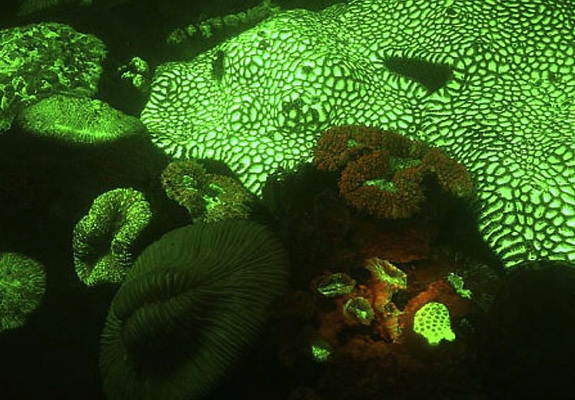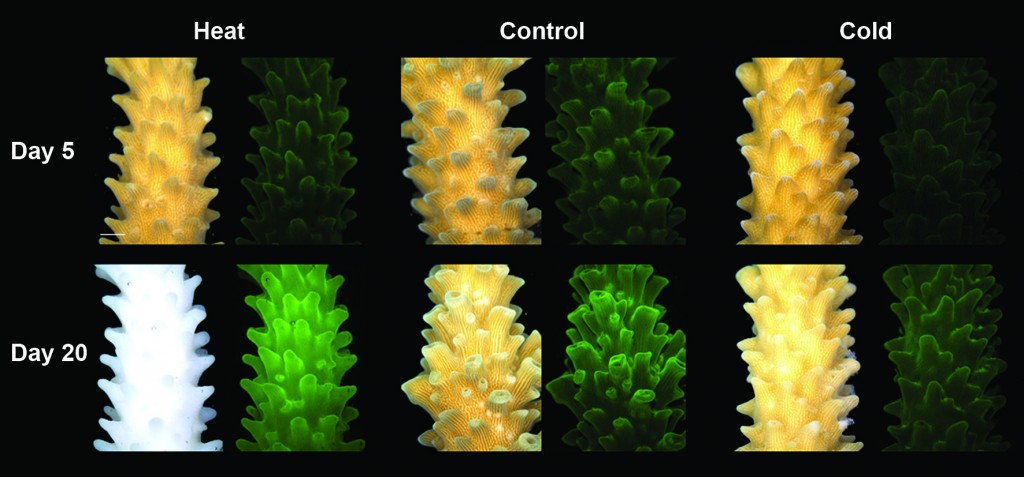Stressed Corals Dim Then Glow Brightly Before They Die
Measuring how coral fluorescence changes may serve as an early indicator of the declining health of a reef
![]()

Fluorescent proteins all aglow in these corals. Photo by Michael Lesser and Charles Mazel, NOAA Ocean Explorer
Anyone who has gone scuba diving or snorkeling in a coral reef will likely never forget the dazzling colors and other-worldly shapes of these underwater communities. Home to some of the world’s most diverse wildlife hotspots, reefs are worth an annual $400 billion in tourist dollars and in the ecosystem services they provide, such as buffering shores from storms and providing habitat for fish that people eat.
Yet it’s a well known fact that coral reefs around the world are in decline thanks to pollution and rapidly warming oceans. However, determining just how reefs are faring–and designing steps to protect them–requires a way to accurately measure their health. Researchers tend to rely upon invasive, damaging techniques to figure out how corals are coping, or else they perform crude spot checks to determine reef health based on coral color alone. But now, scientists have announced a new method of determining coral health that relies upon measuring the intensity of corals’ fluorescent glow.
Yes, glow. Corals naturally produce fluorescent proteins which glow an eery green when seen under a blue light–nearly all corals exhibit this physiological phenomenon.
“This is the first study to follow the dynamics of coral fluorescence and fluorescent protein levels during temperature stress, and shows that coral fluorescence could be utilized as a early indicator of coral stress,” said Melissa Roth, a marine biologist at the University of California, Berkeley (formerly of the Scripps Institution of Oceanography at the University of California, San Diego), in an email. “Because coral fluorescence can be measured non-invasively in the field, it could be an important tool for management of reefs,” she said. Roth and her colleague Dimitri Deheyn described their findings this week in Scientific Reports.
The degree to which a coral glows depends largely on another group of organisms, dinoflagellate algae. Corals are actually a symbiotic assembly of itself and these microscopic dinoflagellate algae–the dinoflagellates help corals attain nutrition, which in turn fuels the growth of coral reefs. The tiny organisms are also responsible for giving corals their typical brownish hue.
But dinoflagellates can abandon ship due to stressors such as increased temperature, a phenomenon known as coral bleaching. Left on their own without the aid of their dinoflagellate covering, the corals’ naturally white skin becomes glaringly visible. The coral can live for a little while after a dinoflagellate exodus, but not for long. If the algae do not return, the coral will die.
Knowing this, Roth and Deheyn decided to investigate how coral fluorescence might reflect the current state of a coral and its dinoflagellates’ relationship. They chose to use Acropora yongei, a common branching coral, in their experiments since it’s often one of the first corals shows signs of stress and bleaching in a reef. They subjected individual corals to one of two different experimental setups in their lab. In some containers, they pummeled corals with cold water, and in others they doused corals in hot water. Another group of corals served as a control. Then they let the corals pickle in their temperature-regulated waters for almost three weeks.
The researchers found a distinct correlation between the degree of bleaching and the concentration of a coral’s fluorescent proteins, which in turn determined the strength of it’s glow. In the first 4 to 5 days, the fluorescent protein concentration and glow of both cold and heat-treated corals dropped. But by the end of the 20-day experiment, cold-stressed corals had acclimated and recovered to their normal level of fluorescence. Heat-stressed corals, on the other hand, bleached and began to glow even more strongly, probably because their dinoflagellate communities no longer blocked the coral’s underlying fluorescence. Like a supernova before a star’s final collapse, the corals send out a steady stream of intense glow just before their inevitable demise.

Corals pictures under white light (left panels) and blue light (right panels) show how corals subjected to heat stress eventually bleached and increased their fluorescent glow by the end of the experiment. Photo by Melissa Roth, Scientific Reports
After death, the glow stops. In a reef system, the bone white coral would gradually get masked by a film of green algae that coats the ruins of the now deceased organism.
Once corals start to bleach, conservationists or wildlife managers have few options for helping reefs as they begin to decline and often eventually die. But if they catch the problem ahead of time, they could try to help the coral with strategies such as shading with artificial structures or sediments, adding antioxidants to the water or introducing heartier dinoflagellates, though scientific studies validating these potential rescue methods are largely lacking.
This new finding, Roth hopes, can be used to preempt reef collapse, serving as a sort of canary in the coal mine for corals in distress. “Managers could focus on the most sensitive corals on a reef, like branching corals, and look for rapid drops in fluorescence as an early sign of stress,” Roth said. This would give them about a week-long window to take action before full-blown bleaching began. “Bleaching would be like a heart attack,” she explained. “You would rather detect signs of high blood pressure or clogging of the arteries to address and avoid a heart attack.”
Managers who want to visualize their reef’s health can observe the glow by using a blue flashlight and a yellow filter over their snorkel mask, or they can film the phenomenon with a camera equipped with these same features. If managers notice the initial drop in coral glow that indicates an impending problem, for example, immediate action could perhaps be taken to try and rescue the reef.
“So the idea is that we can use coral fluorescence as a early indicator of coral health prior to bleaching, which could actually give time for managers to do something if they wanted to take actions to protect the reef. Obviously that may be difficult on a large scale,” she explained, adding that “as reefs become degraded the few that we have left might be protected more aggressively.”
Further research on how these findings might apply to other species of coral is needed, the authors write. They also hope that future studies will combine biology with engineering to help design a digital imaging system that better captures and quantifies the extent to which corals change their glow.
/https://tf-cmsv2-smithsonianmag-media.s3.amazonaws.com/accounts/headshot/Rachel-Nuwer-240.jpg)
/https://tf-cmsv2-smithsonianmag-media.s3.amazonaws.com/accounts/headshot/Rachel-Nuwer-240.jpg)